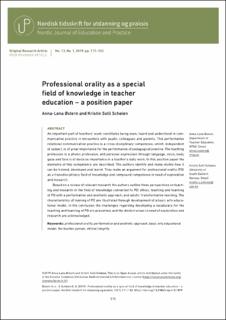| dc.contributor.author | Østern, Maria Anna-Lena Viola | |
| dc.contributor.author | Schøien, Kristin Solli | |
| dc.date.accessioned | 2020-02-18T14:28:07Z | |
| dc.date.available | 2020-02-18T14:28:07Z | |
| dc.date.created | 2019-11-09T20:02:47Z | |
| dc.date.issued | 2019 | |
| dc.identifier.citation | Nordisk tidsskrift for utdanning og praksis. 2019, 13 (1), 111-132. | en_US |
| dc.identifier.issn | 2535-7697 | |
| dc.identifier.uri | https://hdl.handle.net/11250/2642379 | |
| dc.description.abstract | An important part of teachers’ work constitutes being seen, heard and understood in communicative practice in encounters with pupils, colleagues and parents. This performative relational communication practice is a cross-disciplinary competence, which, independent of subject, is of great importance for the performance of pedagogical practice. The teaching profession is a phonic profession, and personal expression through language, voice, body, gaze and face is of decisive importance in a teacher’s daily work. In this position paper the elements of this competence are described. The authors identify and make visible how it can be trained, developed and learnt. They make an argument for professional orality (PO) as a transdisciplinary field of knowledge and compound competence in need of exploration and research. Based on a review of relevant research the authors outline three perspectives on teaching and research in the field of knowledge connected to PO: ethics, teaching and learning of PO with a performative and aesthetic approach, and adults’ transformative learning. The characteristics of training of PO are illustrated through development of a basic arts educational model. In the conclusion the challenges regarding developing a vocabulary for the teaching and learning of PO are presented, and the distinct areas in need of exploration and research are acknowledged. | |
| dc.language.iso | eng | en_US |
| dc.rights | Navngivelse-Ikkekommersiell 4.0 Internasjonal | * |
| dc.rights.uri | http://creativecommons.org/licenses/by-nc/4.0/deed.no | * |
| dc.title | Professional orality as a special field of knowledge in teacher education – a position paper | en_US |
| dc.type | Peer reviewed | en_US |
| dc.type | Journal article | en_US |
| dc.description.version | publishedVersion | |
| dc.source.pagenumber | 111-132 | en_US |
| dc.source.volume | 13 | en_US |
| dc.source.journal | Nordisk tidsskrift for utdanning og praksis | en_US |
| dc.source.issue | 1 | en_US |
| dc.identifier.doi | 10.23865/up.v13.1899 | |
| dc.identifier.cristin | 1745671 | |
| cristin.ispublished | true | |
| cristin.fulltext | original | |
| cristin.qualitycode | 1 | |

